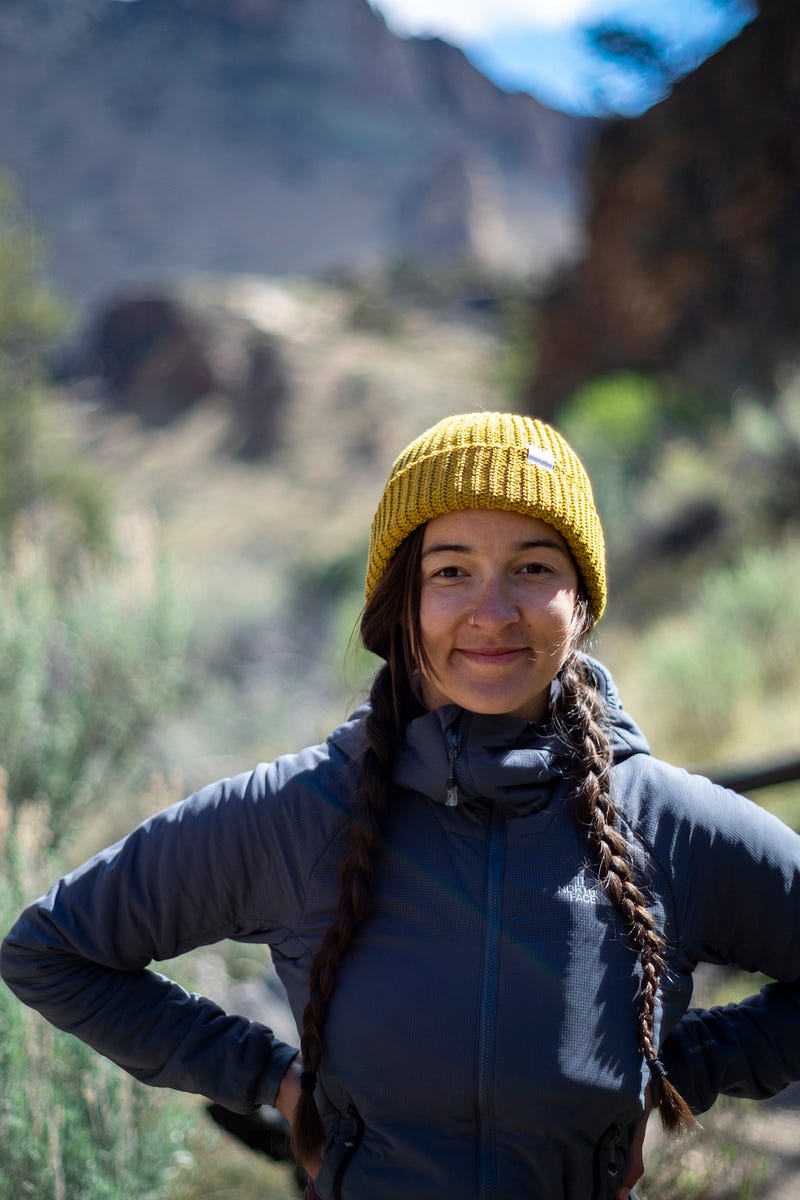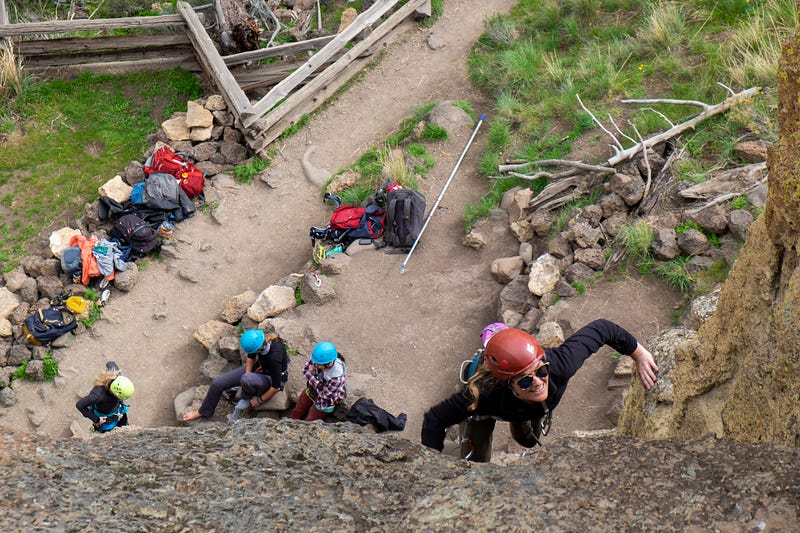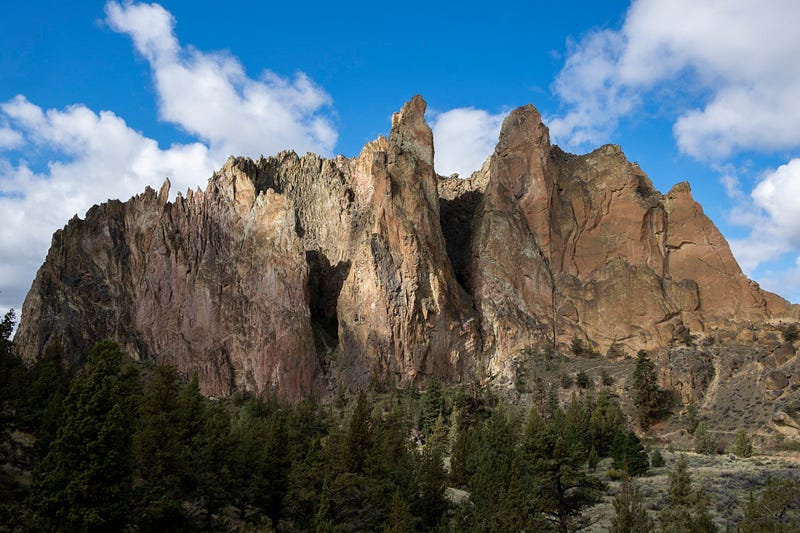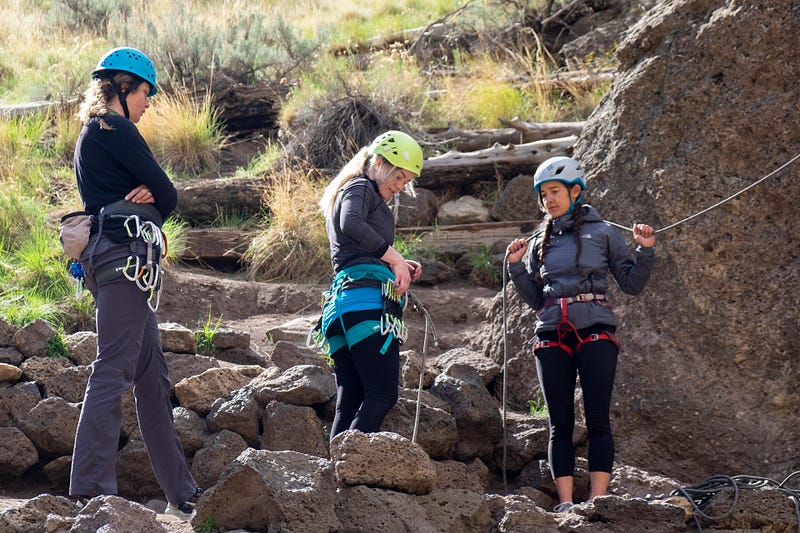Moving Mountains
Lizzy VanPatten strives to change climbing community demographics
Story and Photos by TREVOR DICKIE

Smith Rock State Park is a climber’s oasis in Eastern Oregon’s high desert. The roads approaching the park treat travelers to glimpses of red and orange towers of rock. Walking a hundred yards into the park opens up a view of the Crooked River winding back and forth between the cliffs. The park fills up early on the weekends, with rows and rows of Subarus of all shapes and sizes. Dusty vans, trucks that double as homes and sedans jam-packed with gear line up by 9 a.m. on spring Saturdays. Hikers fill the trails. Climbers dot the walls all around in bright-colored garb, standing out from any park viewpoint. A climber’s paradise, but like every other climbing area around, it’s a place dominated by men.
Lizzy VanPatten, with her deep brown hair and shorter stature, is wearing a mustard-colored beanie and gray North Face jacket held down by her harness. As the co-founder of the guiding organization She Moves Mountains, it’s hard to keep her from guiding. Even though she isn’t one of the guides for the day, she’s absorbed in the group’s process.
VanPatten graduated from Western Washington University with degrees in mathematics and political science/social studies. After hiking around the Chuckanut Mountains and the North Cascades, VanPatten decided she wanted to climb Mount Baker, and joined an American Alpine Institute (AAI) course. During the course, VanPatten climbed Mount Baker as well as some peaks in the Washington Pass area of the North Cascades. She says that’s when she fell in love with rock climbing.
“I got my rock climbing gear the next month, and then bought a one-way ticket to South America, where I went to climb the mountains of Patagonia for about four months,” VanPatten says.
Upon returning, she moved to Smith Rock, Oregon to pursue rock climbing guiding. She received the Guide Like Liz scholarship from the AAI, which honors the late Liz Daley, a professional climber and American Mountain Guides Association( AMGA)-certified guide. According to AAI’s website, the purpose of the scholarship is “to encourage women who possess an affinity for the mountains and mountain culture to be able to pursue their dreams and passions and explore guiding as a career.”
“In all of these experiences I was the only woman in my guiding course, I was the only woman when I took my mountaineering course from AAI,” VanPatten says. “When I went to Smith there was one other woman who was a guide out of all of the main companies at Smith Rock, so her and I decided to start running women’s clinics.”

The clinics were run under Chockstone Climbing Guides, but by the second year the clinics were too popular for Chockstone to contain their growth, VanPatten says. A successful Indiegogo fundraiser raised over $13,000 to cover insurance and acquire the necessary gear to get started. This allowed over 90 women to attend clinics in the She Moves Mountains inaugural 2017 season.
Going into its second season, four guides have been hired and clinics have become more frequent and varied in its subjects. In spring 2018, She Moves Mountains received its first brand sponsorship from The North Face.
“That’s a big deal for us, and they are going to be helping us spread the word about She Moves Mountains.” VanPatten says.
When talking about sexism and gender issues in the climbing community, VanPatten says the pressure on women in climbing spaces is intense.
“I haven’t had to deal too much with people being outright sexist, the problem is that when you’re the only woman in a situation, you carry this enormous weight on you,” she says. “For me in all of those situations, like the mountaineering course, I was the only woman with 10 men. Before the course was coming up I trained my ass off.”
Being the only woman in these situations, VanPatten says it was like she was representing not just herself, but her gender as well.

“If I felt weak or if I felt tired, I felt like I couldn’t express that,” she says. “Because if I was tired or I was weak then I was showing them that women can’t keep up.”
Beyond feeling the need to prove her fitness, VanPatten experienced situations where she had to prove herself capable.
“I’ve walked in on conversations where people have been like, ‘Wow, I’m surprised Lizzy’s strong,’ or people ask if my boobs get in the way when I climb,” she says. “Just little comments and it’s just a misunderstanding, they don’t understand.”
In a study commissioned by REI for its Force of Nature campaign, over 2,000 women across the country were surveyed. The study found that six in every 10 women feel men’s interests are taken more seriously when it comes to the outdoors, and 63 percent of women couldn’t think of a female outdoor role model. Also, 73 percent of women stated they would like to spend more time outside.
In April 2018, a photo of a climber at one of the She Moves Mountains clinics showed up on a popular climbing Instagram dedicated to poking fun at gear, rope systems and safety mishaps. At the time, it was somewhat odd to have a photo of a climber on the page. The climber was doing a mock-lead, where they practice leading techniques, while still safely attached in a top rope setup. The knot used to tie in was questioned, and the whole photo was mocked for the climber’s odd situation.
VanPatten contacted the owner of the account and the post was taken down. The photo was misinterpreted, but some comments on the post had sexist undertones.
“It’s just a feeling I have, that people want to find us fucking up, so they can call us out and invalidate what we do,” she says. “If you looked at the comments they’re all men asserting that they know more than I do even though I’m a credentialed guide.”

Within the clinics, VanPatten says letting participants work through their fear and personal struggle in a space where they are comfortable can make or break the experience.
“No matter who you are, at one point in time, climbing is going to be intimidating and scary but if you’re never given a space to express that fear, then you’re just going to bottle it up and have a poor experience,” she says.
The climbing community is one with a long history of mentorship. Skills and techniques have been passed on through first-hand experience and teaching. Many of the important skills of climbing can’t be learned through books or YouTube. The problem with that, is potential mentors in the climbing community are a primarily male.
VanPatten says often men gravitate toward taking on younger men to be their mentee. They aren’t intentionally being sexist, but rather see themselves in the younger men. She says there can be a connotation attached to the idea of an older man taking on a younger woman.
“It’s not that the men are actively holding women back, it’s just that we’ve been held back for so long. And as we’re emerging, we need more leadership to learn from because we don’t have any,” VanPatten says.
Hailey Jongeward, a Bellingham climber who has some experience guiding rock climbing, says what VanPatten is doing is really important for up-and-coming female climbers.
“I don’t think women are given many opportunities to feel encouraged and safe to learn a new sport like climbing and to work their way up in the guiding world,” she says. “I don’t think there’s anything quite as powerful as a group of women coming together to help each other do badass things.”
As She Moves Mountains grows, more women are becoming able to step into those roles. The organization is also giving opportunities and raising awareness for female guides, and not just in the Pacific Northwest.
“Right now, there’s a branch in Chattanooga, Tennessee that will be running a crowdfunding campaign soon to also start their own She Moves Mountains,” VanPatten says.
This isn’t a quick fix. Male dominance in the climbing world has been reinforced over generations of climbers, but with VanPatten, along with others getting more women into climbing and mentorship roles, it will balance out.
Places like Smith Rock won’t be a paradise mostly for men, and female beginners won’t have to carry the weight of their gender when they want to spend some time on the rock.
